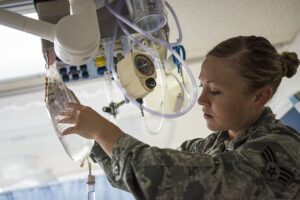This subcourse is concerned with knowledge that is vital in order to understand the “whys” and “hows” for using the intravenous route to administer the kinds of fluids that can save life and limb.

You should possess the knowledge to correct and expand on the medical procedures used by the Combat Medical Specialist and also have the ability to interact with the physicians and physician assistants who will have the final responsibility for treating battle injuries and illnesses.
Some of the terms used in this course may be unfamiliar to you. You will have frequent contact with the physician and physician assistants and will need to understand their vocabulary. It would be wise to use one of the excellent medical dictionaries available in most bookstores and libraries. Some examples are the latest editions of Dorland’s Illustrated Medical Dictionary (published by W. B. Saunders Company) or Taber’s Cyclopedia Medical Dictionary (published by F. A. Davis Company). For general English usage, an example is Webster’s New Collegiate Dictionary (published by G. and C. Merriam Company). Do not feel restrained by these examples. Any good dictionary will be useful.
For your convenience, we have included a glossary of special terms in the appendix at the end of this subcourse. Take a few minutes to read this glossary before you start the lessons. It may save you some dictionary time later.
We suggest that you do not attempt to master large amounts of this information at one sitting. This would be especially difficult if some of the material is new to you.
Contained in the third chapter is the currently accepted method for starting and for discontinuing an intravenous infusion and a blood transfusion. Mastery of this section is not enough to begin giving infusions and transfusions. You must be trained under the supervision of a person who is qualified to instruct you in these processes, supervise your practice, and evaluate your skills and abilities very carefully.
Subcourse Components:
This subcourse consists of three lessons and an appendix. They are:
Lesson 1, Human Blood.
Lesson 2, Fluids and Electrolytes.
Lesson 3, Intravenous Preparations and Methods for Administration.
Appendix: Glossary of Terms.
Students who desire credit hours for this correspondence subcourse must meet eligibility requirements and must enroll through the Nonresident Instruction Branch of the U.S. Army Medical Department Center and School (AMEDDC&S).
